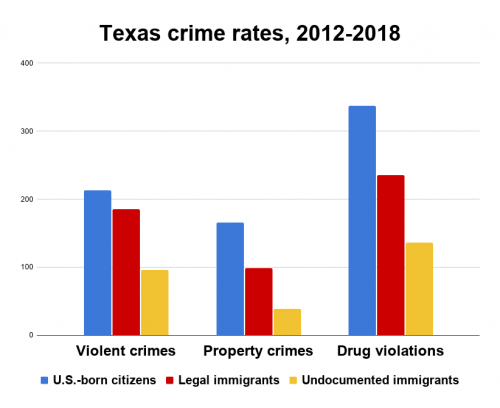Undocumented immigrants far less likely to commit crimes in U.S. than citizens
Crime rates among undocumented immigrants are just a fraction of those of their U.S.-born neighbors, according to a first-of-its-kind analysis of Texas arrest and conviction records.
Compared to undocumented immigrants, U.S. citizens were twice as likely to be arrested for violent felonies in Texas from 2012 to 2018, two-and-a-half times more likely to be arrested for felony drug crimes, and over four times more likely to be arrested for felony property crimes, according to a study published by University of Wisconsin–Madison researchers today in the Proceedings of the National Academy of Sciences.

Michael Light
With new access to Texas’ computerized criminal history data for more than 1.8 million arrests over six years, UW–Madison sociology professor Michael Light and co-authors Jingying He and Jason Robey — who were both UW–Madison graduate students — were able to directly calculate the rates at which U.S.-born citizens, legal immigrants and undocumented immigrants were arrested for a range of felony offenses.
Previous studies, including others published by Light, have drawn similar, though less direct, conclusions. These studies were limited to comparing crime rate trends to immigration trends, because records matching crimes to the immigration status of perpetrators weren’t available.
“It’s like asking if crime rates rise when unemployment goes up. That’s not the same as asking if unemployed people commit more crimes,” says Light, who led the new study. “Those are related questions, but not the same question.”
One of the reasons Texas keeps such fine-grained records on offenders is the federal government’s Secure Communities Program, which mandates sharing information on immigration status and is pitched as a way to deport criminals before they can commit more crimes in the United States
 While immigration is a top priority of federal law enforcement agencies, undocumented immigrants are far more likely to encounter local law enforcement officers than federal agents. Through Secure Communities, when local police book arrested suspects, their biometric information is compared to federal databases, giving U.S. Immigration and Customs Enforcement notice when a non-citizen is arrested.
While immigration is a top priority of federal law enforcement agencies, undocumented immigrants are far more likely to encounter local law enforcement officers than federal agents. Through Secure Communities, when local police book arrested suspects, their biometric information is compared to federal databases, giving U.S. Immigration and Customs Enforcement notice when a non-citizen is arrested.
But at least two independent studies suggest Secure Communities didn’t have any effect on crime rates, according to Light, despite deporting more than 200,000 people in its first four years.
“If the plan was to make communities safer, to reduce the likelihood of, say, a felony violent assault in these communities through deportation, it did not deliver on that promise,” Light says. “Our results help us understand why that is. The population of people we deported simply were not a unique criminal risk. Removing them isn’t going to make you all that safer.”
While the new study can’t describe why undocumented immigrants commit fewer crimes, it’s a common finding that first generation immigrants tend to be less crime prone — and undocumented immigrants are, almost by definition, first generation immigrants. Light believes there are many reasons to expect a lower crime rate among undocumented immigrants.
“They have a tremendous incentive to avoid criminal wrongdoing. The greatest fear among undocumented immigrants is getting in legal trouble that leads to deportation,” says Light, whose work is supported by the National Science Foundation and National Institute of Justice.
Another factor at work may be that immigration, especially illegal entry into the U.S., is not easy. It attracts people with particular motives.
“There’s lots of opportunity to commit crimes in Mexico and Venezuela and other places people are emigrating from,” Light says. “The argument is that many people who want to immigrate are selected on attributes like ambition to achieve, to find economic opportunities, and those types of things aren’t very highly correlated with having a criminal propensity.”
The researchers repeated their crime-rate analysis with subtle shifts in data — using convictions instead of arrests, misdemeanors in addition to felonies, size estimates of undocumented immigrant populations from both the Pew Research Center and the Center for Migration Studies.
The much lower crime rates for undocumented immigrants remained in each case, results Light thinks should be useful in immigration policymaking.
“The conversation about undocumented immigration should be informed by the best empirical evidence,” he says. “If somebody says we know undocumented immigrants increase the crime rate, well, I’d say the weight of evidence is not in their favor.”
This research was funded in part by grants from the National Science Foundation (award No. 1849297) and National Institute of Justice (2019-R2-CX-0058).




